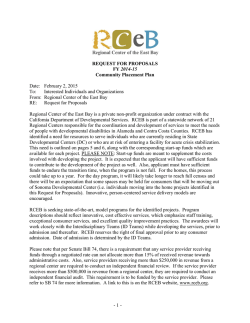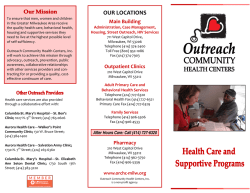
Policy Brief: One-Stop Shopping: Efforts to Integrate Physical and
Health Policy Brief January 2015 One-Stop Shopping: Efforts to Integrate Physical and Behavioral Health Care in Five California Community Health Centers Nadereh Pourat, Max W. Hadler, Brittany Dixon, Claire Brindis SUMMARY: More than 70 percent of behavioral health conditions are first diagnosed in the primary care setting. Yet physical and behavioral health care are typically provided separately, compelling many vulnerable patients to navigate the complexities of two separate systems of care. This policy brief examines five community health centers (CHCs) in California that have taken preliminary steps toward creating “one-stop shopping” for both physical and behavioral health care. The steps taken to increase integration by the CHCs include employing behavioral health providers, S egregation and lack of coordination between primary care providers (PCPs) and behavioral health providers (BHPs) are significant problems. More than 70 percent of behavioral health conditions are diagnosed and treated with medications in the primary care setting, yet PCPs frequently do not have the training to identify behavioral health problems or the resources to provide all of the care that symptomatic patients need.1,2,3,4 Complex patients with both behavioral and physical conditions often have high rates of emergency department visits and hospitalizations, and they often receive inadequate care.5 using a single electronic health record that includes both physical and behavioral health data, transforming the physical space, and developing mechanisms for effective transition of patients between providers. The findings emphasize the importance of changes to MediCal reimbursement policies to promote sameday visits, as well as the importance of cultural changes to integrate behavioral health. They also highlight the need for comprehensive tools to assess and promote integration and to identify solutions for the most challenging activities required to achieve full integration. Behavioral health includes mental health care, substance abuse treatment, and behavioral modification. Participating CHCs were asked about integration of all such services. The focus on the Triple Aim of better care, better health, and lower costs mandated by the Affordable Care Act has intensified efforts to improve the health of complex patients. Increasingly, physical and behavioral health integration is being targeted by policymakers as a promising approach to improving the health of publicly insured and uninsured patients, and at the same time reducing their health care costs. Best Practices (Highest Score) in Physical and Behavioral Health Integration INFRASTRUCTURE Exhibit 1 UCLA CENTER FOR HEALTH POLICY RESEARCH CARE DELIVERY PROCESS 2 Physical proximity of primary care providers (PCP) and behavioral health providers (BHP) Same facility, same practice space, organized in teams, in pods or same offices Type and number of BHPs in primary care setting 1 or more full-time non-psychiatrist BHPs, 2 or more full-time psychiatrists Combined electronic health records (EHR) and sharing of physical and behavioral health patient records Shared EHR, data fully shared Level and mode of communication or collaboration between PCPs and BHPs As needed, for shared patients, for consultation and coordination of treatment plans, regular PCP/BHP team meetings and morning huddles Frequent behavioral health screening and assessment Assessment as needed, regular screening of new patients, regular screening of existing patients Joint treatment planning by PCPs and BHPs Single collaborative plan Referrals and transitions from primary care to behavioral care Referrals to internal BHP, PCP access to BHP records in EHR, frequent warm handoffs, joint/same-day PCP and BHP visits Leadership support for behavioral health integration Unequivocally and strongly supportive PCP buy-in for behavioral health integration Active practice change Source: Adapted from the SAMHSA-HRSA Standard Framework for Levels of Integrated Healthcare. (http://www.integration.samhsa.gov/integrated-care-models/ CIHS_Framework_Final_charts.pdf) UCLA CENTER FOR HEALTH POLICY RESEARCH Evaluated and Self-Assessed Physical and Behavioral Health Integration Scores of Participating Community Health Centers, 2014 5.7 5.4 Neighborhood Healthcare 5.4 5.6 LifeLong Medical Care 5.2 Petaluma Health Center Evaluated 5.0 4.9 5.2 Axis Community Health Exhibit 2 5.0 4.3 Vista Community Clinic Self-assessed Source: UCLA evaluation of participating community health centers (CHCs) and CHCs’ self-assessment. The integration of the mental health and substance abuse spheres of care in the primary care setting has been most recently promoted by the Substance Abuse and Mental Health Services Administration (SAMSHA) and Health Resources and Services Administration (HRSA).6 The SAMSHA/HRSA conceptual framework for integration identifies three basic approaches to care: coordinated, co-located, and integrated. The consistent implementation of this framework requires a particular infrastructure, certain processes of care delivery, and targeted financial incentives or reimbursement. This framework is intended to be used by organizations to assess their progress toward integration, but it lacks the specific detail to facilitate such assessment. We developed a scoring tool to measure the level of physical and behavioral health integration in community health centers (CHCs), which provide much of the primary health care to underserved and low-income populations. 3 CHCs are an integral source of care for many low-income populations and have been at the forefront of integration efforts. We developed four infrastructure and five care delivery process measures, each assessed on a scale ranging from 1 (minimal collaboration) to 6 (complete collaboration in a fully integrated setting). The optimal level of integration (6) is displayed in Exhibit 1. Complete details on all levels of integration are provided in the Appendix, Exhibit A.7 Participating CHCs Have Made Significant Progress Toward Integration All five CHCs showed evidence of significant integration, with scores excelling beyond level 4 on the SAHMSA/HRSA integration model (4.3 to 5.7, Exhibit 2). The CHCs’ self-assessment ranged from 4.9 to 5.6. CHCs reported various reasons for their motivation for behavioral health integration, including enhancing their ability to improve patients’ health and care outcomes, participating in quality improvement collaboratives, and receiving grants that promoted integration. 4 Exhibit 3 UCLA CENTER FOR HEALTH POLICY RESEARCH Number and Ratio of Behavioral Health Workforce per Patient in Participating Community Health Centers, 2014 7.7 19.0 1.2 6.8 6.5 5.0 4.9 4.3 2.4 1.5 1.0 Neighborhood Healthcare LifeLong Medical Care Petaluma Health Center Axis Community Health Vista Community Clinic Patients per psychiatrist ratio 29,595 10,775 25,813 – – Patients per other BHP ratio 4,524 1,158 2,581 408 21,880 Staff psychiatrist Clinical psychologist (PsyD)/licensed clinical social worker (LCSW) Marriage and family therapist (MFT)/mental health nurse/intern (MFT, LCSW, PsyD) Substance abuse/addiction specialist Source: Staffing levels were obtained from UCLA interviews, and the number of unique patients was obtained from the 2013 Office of Statewide Health Planning and Development primary care clinic utilization data. Note: BHPs are measured in terms of full-time equivalent staff (FTE). The percentage of time spent by each BHP is added to create one FTE. For example, two individuals each working 50% of the time would equal one FTE. All CHCs scored highly (6) on data sharing, reporting that they used a single electronic health record (EHR) with all data visible to PCPs and BHPs, with occasional and minor restrictions on some confidential notes (Appendix, Exhibit B7). Similarly, nearly all CHCs reported full leadership support for integration (6). The most variation was reported in the physical proximity of BHPs to PCPs, the number and/or type of BHPs providing care in the primary care setting, and transitions of patients from PCPs to BHPs. All CHCs had some challenges in frequency/methods of communication between PCPs and BHPs and in whether these providers jointly planned for the care of complex patients. The BHP workforce in participating CHCs varied considerably. All CHCs employed clinical psychologists and licensed clinical social workers. Three CHCs also employed marriage and family therapists, mental health nurses, or interns, and one employed substance abuse specialists (Exhibit 3). The three CHCs with the highest integration scores had psychiatrists on staff, a major step toward building the capacity to provide a broader range of care and the ability to better manage the care of complex patients within UCLA CENTER FOR HEALTH POLICY RESEARCH the organization. The psychiatrists provided medication-assisted treatment and were able to provide training, tools, and helpful hints to internal PCPs and other staff. Psychiatrists in one CHC also provided telepsychiatry to other sites in the organization. Clinical psychologists and licensed clinical social workers provided therapy and behavioral modification for patients with chronic diseases such as diabetes. In some CHCs, they also offered group behavioral health visits. In general, availability of psychiatrists improved the PCPs’ level of comfort with medication management and behavioral health screening, and the availability of BHPs promoted spontaneous discussion of patient needs or handoff of patients who needed behavioral health care with PCPs. The number of psychiatrists and other BHPs per number of patients as an estimate of the capacity of CHCs to address the behavioral health care needs of their patients was also examined (Exhibit 3). They were occasionally able to retain these individuals once they were licensed, but this did not address the shortage of licensed and experienced BHPs. CHCs underscored the importance of placing PCPs and BHPs in the same physical space to build stronger relationships and promote frequent and timely communication among care teams. Some CHCs had changed their physical environment to place clinical care teams within pods or to provide a shared physical space for PCPs and support staff. In most cases, BHPs were still physically separated from the PCP teams and were in private offices, particularly because the particular requirements of BHP offices (e.g., comfortable seating, appropriate lighting, longer appointments) differ from PCP offices. Some CHCs lacked the physical space or resources to reorganize teams in pods, but instead used cell phones or other devices to facilitate warm handoffs or brief consultations. CHCs Have Significant Challenges to Integration Infrastructure. Recruitment of staff psychiatrists and bilingual psychologists or licensed clinical social workers was a significant challenge for the CHCs. This was in part due to lack of availability of BHPs with these skills in the CHCs’ service areas. CHCs’ perceived lack of resources led to difficulties in providing competitive salaries and benefits to recruit highly skilled BHPs. CHCs also found it challenging to employ a sufficient number of BHPs to address the high level of need among their patients. Most organizations noted that their current number of BHPs was insufficient, particularly if they followed guidelines to regularly screen patients for behavioral health problems. One CHC noted the moral challenges of identifying children with behavioral health needs and not having the capacity to provide the needed care. Some CHCs were able to leverage special project funds and resources to add psychology or social work interns to increase their BHP capacity. “Warm handoff” A warm handoff occurs when a primary care provider introduces a patient to a behavioral health provider during a clinic visit. This in-person contact enhances continuity of care and may increase the patient’s confidence in the behavioral health provider because of the direct referral from a trusted source. Warm handoffs often make patients more likely to keep subsequent appointments. Source: Integrated Behavioral Health Project. (http://www.ibhp.org/?section=pages&cid=122) 5 6 UCLA CENTER FOR HEALTH POLICY RESEARCH Care Delivery Process. Lack of funding for integration activities made it difficult to require BHPs to participate in essential integration activities such as morning huddles, joint care planning for complex patients, and regular meetings between PCPs and BHPs. Some CHCs employed and trained support staff to attend morning huddles and streamline the transition between physical and behavioral health care. However, joint care planning and regular PCP and BHP meetings were particularly financially challenging because these activities were not reimbursed adequately or specifically. Demand for patient care was also too great to allow sufficient time for these activities. CHCs were challenged in their efforts to see complex patients on the same day or to conduct joint visits by a PCP and BHP. CHCs noted that these approaches were the most effective for addressing the needs of complex patients, who frequently do not come back for a separate visit on another day. CHCs highlighted the challenges of ensuring availability of BHPs for warm handoffs, given the high level of demand for their services. In addition, CHCs emphasized the loss of revenue associated with same-day or joint visits because California Medi-Cal policies prohibit reimbursement for same-day visits.8 Even if most managed care organizations pay an established fee-for-service rate for these visits, Medi-Cal does not pay the difference between this rate and the prospective payment rate CHCs would receive for visits conducted on different days. Such policies reduce the ability of CHCs to effectively address their patients’ behavioral health needs. Despite the availability of psychiatrists, CHCs continued to struggle to provide care for highly complex patients with serious mental illness in the primary care setting. CHCs noted difficulties such as other patients’ having to share waiting rooms with complex patients with disruptive behavior, the ability of primary care staff to manage such patients, and the challenges of building trust with PCPs to provide care for these patients. One CHC commented that behavioral and primary care silos for most complex patients will continue to exist, indicating the importance of providing primary care in behavioral health settings and of reverse integration, as well as of training PCPs and building the skills required to treat such patients. Most CHCs referred highly complex patients to specialty BHPs and had significant trouble obtaining feedback. One CHC employed psychiatrists who were also licensed in internal medicine or family practice, and had a behavioral health specialty clinic site within its organization. These dually licensed physicians were able to provide primary care in the specialty site to highly complex patients who were disruptive or had difficulty trusting other providers. Measurement, Practice, and Policy Implications The findings highlight the challenges of measuring behavioral health integration. The assessment tool presented in this brief can be easily used by organizations to conduct an initial assessment of needed infrastructure and care delivery processes. The tool can also be used to assess the current prevalence of integration in similar organizations. However, further revision of the tool is required to address such other dimensions as effective change in organizational culture and depth of leadership commitment, competencies of BHPs and PCPs in integrated care delivery, and the frequency with which BHPs and PCPs work as integrated teams to care for complex patients. The findings also highlight the challenges and the progress of five CHCs in achieving the initial stages of integration. While employment of BHPs is a necessary first step, the findings highlight the importance of assessing the adequacy of the BHP workforce and identifying solutions to improve recruitment of BHPs in the primary care setting. Including BHPs in organizational leadership and incorporating behavioral health care in the strategic plan can be effective recruitment tools. Including UCLA CENTER FOR HEALTH POLICY RESEARCH brochures and other informational materials in waiting and exam rooms could also signal the availability of an organization’s behavioral health capacity. Telepsychiatry can be an option for addressing the shortage of psychiatrists in CHCs. Incorporation of community health workers, interns, or other staff trained to support integration activities is another effective approach. The findings indicate the importance of redesigning care to truly address patients’ behavioral health needs. While measures such as increasing the physical proximity of BHPs and PCPs are necessary, they are insufficient to ensure joint planning for the care of complex patients. Incorporating behavioral health in quality improvement initiatives and establishing integrated clinical guidelines are effective approaches to improving the knowledge base required for integration and for incorporating integration into the daily practices of BHPs and PCPs. Ultimately, integration requires addressing reimbursement challenges. Allowing sameday reimbursement would promote warm handoffs and joint BHP and PCP visits for complex patients, whose outcomes depend on timely management of both physical and behavioral health conditions. Better financing policies would improve the ability of BHPs to spend time in necessary integration activities such as team meetings and quality improvement initiatives. Such policies would also improve the ability of organizations to recruit more BHPs, including case managers and support staff, and to employ bilingual or specialized staff. Author Information Nadereh Pourat, PhD, is director of research at the UCLA Center for Health Policy Research and a professor in the Department of Health Policy and Management at the UCLA Fielding School of Public Health. Max W. Hadler, MPH, MA, is a research associate at the UCLA Center for Health Policy Research. Brittany Dixon is a student at the David Geffen School of Medicine at UCLA and was a graduate student researcher at the UCLA Center for Health Policy Research. Claire D. Brindis, DrPH, is director of the Philip R. Lee Institute for Health Policy Studies at the University of California, San Francisco (UCSF) and a professor of pediatrics and health policy in the Department of Pediatrics and the Department of Obstetrics, Gynecology, and Reproductive Health Sciences at UCSF. Acknowledgments Funding for this project was provided by the Blue Shield of California Foundation. The authors thank Rachel Wick, Mary Rainwater, Elizabeth Morrison, Ninez Ponce, and J. Nwando Olayiwola for their thoughtful reviews. Sincere thanks to the participating CHCs for spending significant time and effort to respond to questionnaires, participate in interviews, and review the findings. Data and Methodology The 2012 California Office of Statewide Health Planning and Development primary care clinic utilization data were analyzed to determine CHCs’ workforce, service provision, and total revenues. We identified five CHCs across California that participated in the Low Income Health Program, were recognized as patient-centered medical homes (PCMH) by the National Committee for Quality Assurance, and employed behavioral health professionals (BHPs). The characteristics of these CHCs are displayed in the Appendix, Exhibit C.7 We closely examined the self-reported level of integration in these CHCs through a detailed questionnaire and site visits or telephone interviews with the medical directors, PCPs, and BHPs.9 We also asked CHCs to self-assess their level of integration using the scoring tool. CHCs were not scored on the frequency with which they adhered to care delivery processes or on exactly how they operationalized some concepts. A score of 6 indicates that a CHC follows these indicators at least some of the time, but it does not indicate complete collaboration in a fully integrated setting. The integration assessment tool presented in this policy brief does not include SAMHSA/HRSA measures on patient experience and business model. Patient experiences were not assessed in this study. Behavioral health and physical care funding sources in participating CHCs were not distinguished. Suggested Citation Pourat N, Hadler MW, Dixon B, Brindis CD. One-Stop Shopping for Health Care: Latest Efforts in Integration of Physical and Behavioral Health Care in Five California Community Health Centers. Los Angeles, CA: UCLA Center for Health Policy Research, 2015. 7 UCLA CENTER FOR HEALTH POLICY RESEARCH 10960 Wilshire Blvd., Suite 1550 Los Angeles, California 90024 Endnotes 1 The UCLA Center for Health Policy Research is affiliated with the UCLA Fielding School of Public Health and the UCLA Luskin School of Public Affairs. 2 3 The analyses, interpretations, conclusions, and views expressed in this policy brief are those of the authors and do not necessarily represent the UCLA Center for Health Policy Research, the Regents of the University of California, or collaborating organizations or funders. 4 PB2015-1 Copyright © 2015 by the Regents of the University of California. All Rights Reserved. Editor-in-Chief: Gerald F. Kominski, PhD 5 Phone: 310-794-0909 Fax: 310-794-2686 Email: [email protected] www.healthpolicy.ucla.edu 6 Read this publication online Blount FA, Miller BF. 2009. Addressing the Workforce Crisis in Integrated Primary Care. J ClinPsych in Med Settings16(1): 113-119. Nasrallah HA, Meyer JM, Goff DC, McEvoy JP, Davis SM, Stroup TS, et al. 2006. Low Rates of Treatment for Hypertension, Dyslipidemia and Diabetes in Schizophrenia: Data from the CATIE Schizophrenia Trial Sample at Baseline. Schizophrenia Research 86(1-3)(Sept): 15-22. PubMed PMID: 16884895. Epub 2006/08/04. eng. Treatment Advocacy Center. What Percentage of Individuals with Serious Mental Illness Are Receiving No Treatment? (http://www.treatmentadvocacycenter. org/storage/documents/what%20percentage%20of%20 individuals%20with%20serious%20mental%20 illnesses%20are%20receiving%20no%20treatment%20 final.pdf) Padilla-Frausto DI, Grant D, Aydin M, AguilarGaxiola S. 2014. Three out of Four Children with Mental Health Needs in California Do Not Receive Treatment Despite Having Health Care Coverage. Los Angeles, CA: UCLA Center for Health Policy Research. PB2014-5: 1-10. Egede LE. 2007. Major Depression in Individuals with Chronic Medical Disorders: Prevalence, Correlates and Association with Health Resource Utilization, Lost Productivity and Functional Disability. Gen Hosp Psychiatry 29(5): 409-16. The current SAMHSA/HRSA model is built on previous notable models, including Doherty’s continuum of collaboration, Blount’s distilled model of collaboration, and Park’s four-quadrant model. A vast number of integrated care initiatives and multiple clinical practice manuals on how to integrate are also available (see: Collins C, Hewson, DL, Munger R, Wade T. 2010. Evolving Models of Behavioral Health Integration in Primary Care. New York, NY: Milbank Memorial Fund. Contract No.: ISBN 978-1-887748-73-5). 7 8 9 See Appendix: http://healthpolicy.ucla.edu/publications/ Documents/PDF/2015/integrationbrief-appendixjan2015.pdf The California State Legislature’s 2014 Senate Bill 1150 proposed allowing for reimbursement of sameday primary care and behavioral health visits. The bill died in the Appropriations Committee. CHC scores are based on self-reported data and are thus subject to perceptions of respondents; variability in the frequency with which activities such as warm handoffs or collaborative care planning occur are highly likely. Therefore, CHCs that scored highly in a given aspect of integration may receive a lower score upon direct observation or infrequent adherence. For example, a CHC that has the capacity to do warm handoffs may do so less than 50 percent of the time. Similarly, care planning meetings may only occur for the most complex patients and not on a frequent basis.
© Copyright 2026





